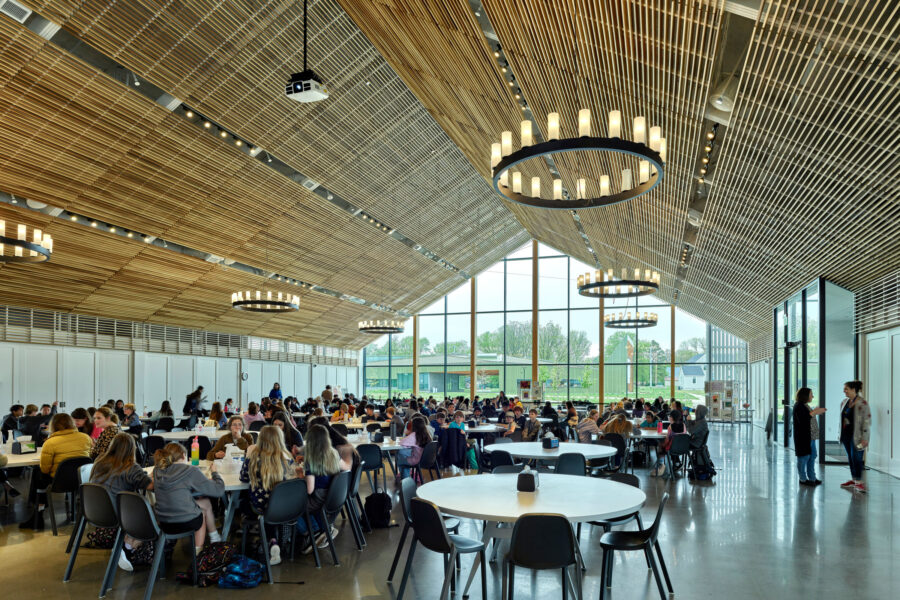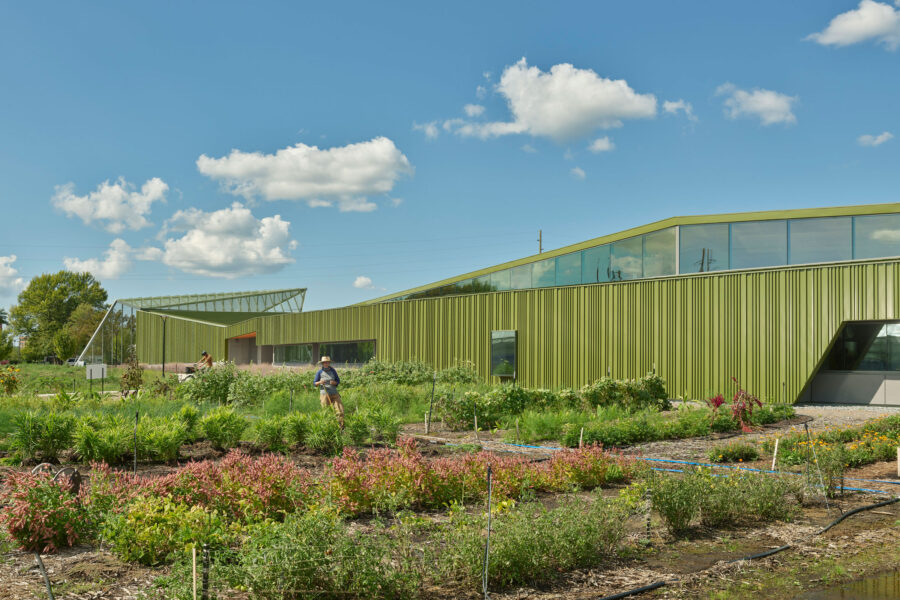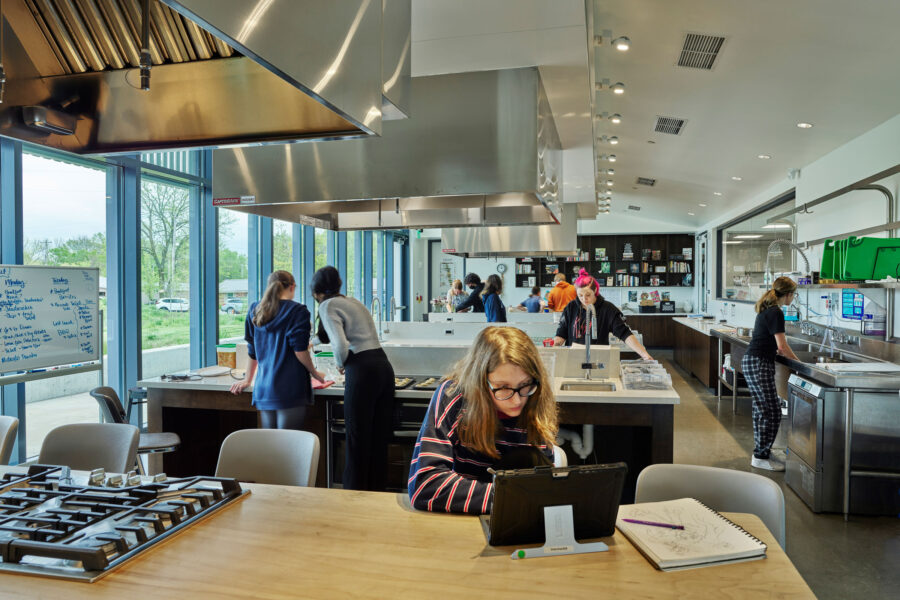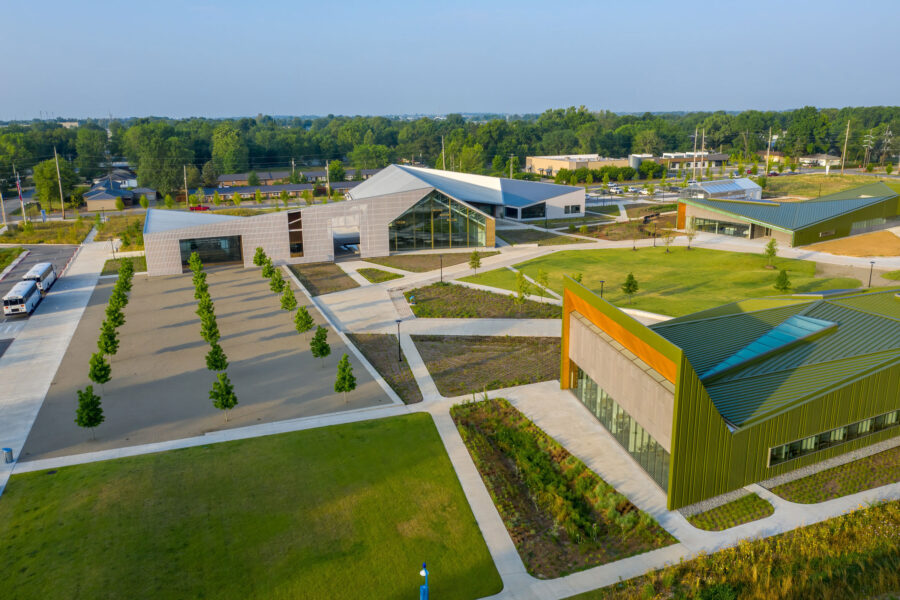Story at a glance:
- EskewDumezRipple designed the Thaden School to challenge traditional paradigms of education.
- The team proposed the campus be modeled more after a small college than a monolithic middle or high school.
- They also sought to answer: How do you reconnect kids to the land to learn about chemistry and biology in a physical way?
It’s a rare opportunity that a school can be imagined from the ground up—with an eye not only to its educational vision, but its environmental impacts on the surrounding community.
Envisioned by the Walton Family Foundation, the nonprofit led by the founders of Walmart based in Bentonville, Thaden School is part of the company’s mission to elevate its hometown as a sophisticated global headquarters that, with record-breaking population growth and new construction, remains pleasantly livable.
The Challenge

The dining hall inside Thaden School’s Home Building is where all of the campus comes together for meals. Photo by Tim Hursley
The challenge posed to our design team involved working with the school’s founders to organize an empty 26-acre site with 125,000 square feet of building program.
A combination of intensive outdoor programming and carefully orchestrated building footprints would theoretically transform the site into a network of indoor and outdoor rooms hosting a variety of functions, programs, and events for Thaden students and faculty as well as the larger Bentonville community.
The design team (led by our firm EskewDumezRipple together with Marlon Blackwell Architects and Andropogon) led the creation of a holistic master plan to guide the school in developing the campus. The founding vision for Thaden School sought to challenge traditional paradigms of education.
The Solution

A lush landscape adjoins Thaden School’s Home Building, with Marlon Blackwell Architects’ Reels building in the background. Photo by Tim Hursley
The master plan proposed the campus be modeled more on a small college campus than a monolithic middle or high school building. In early conversations Founding School Head Clayton Marsh memorably said, “When it’s cold the kids need to feel the weather, and when it rains they need to get wet.” Many classrooms were designed to spill out into adjacent outdoor areas.
This attitude toward circulation was similarly reflected in the distribution of buildings on campus. Academic programs are disbursed across the landscape, each with their own lab/makerspace, where students learn to integrate the movements of their minds and hands.
In turn, the design of individual buildings were divided up among the architectural team, and EskewDumezRipple was tasked with designing the Home Building—the crux of the schools meals program, an amalgamation of science and biology, and an exercise in challenging default ideas of consumption and production. The Home Building simultaneously provides an expansive dining hall, where all of campus comes together for meals.
An early question emerged in developing the building to connect to the school’s curriculum: “How do you reconnect kids to the land to learn about chemistry and biology in a physical way?”

Students take a class in the Teaching Kitchen at Thaden School. Photo by Tim Hursley
Thaden’s urban agricultural program brings a fundamental shift to a traditionally classroom setting. Every aspect of farming—planting seeds, composting, harvesting—is integrated in a way that teaches children about science through their experiences in the world. Students take classes in a state-of-the-art teaching kitchen—a truly unique space in the Home Building and one that deeply espouses the school’s “learning by doing” mantra.
An active greenhouse maintains a prominent position on campus—not hidden away in a quiet corner. The adjacent landscape is a productive one. An urban agriculture program features fruit and vegetable fields, orchards, and planter boxes. The design celebrates this, and everything from the building program (teaching kitchen) to the supporting landscape (paths between buildings built to handle wheelbarrows) was customized in support.
Their integration represents a near-perfect loop. Students harvest crops from the adjacent agriculture program. Crops are cooked and prepared, contributing to student meals. And compost from meals is used to fertilize crops. Integrated tracking dashboards also enable students to monitor their consumption of energy, food, and water in ways that help them appreciate the global impact of local behavior.
The building’s design places sustainability central to students’ education. This begins with an adjacent landscape that acts as a botanical textbook filled with a diversity of plants, flowers, and trees—tallgrass prairie, oak and pecan woodlands, bottomland hardwood forests, freshwater wetlands—a microcosm of the region’s native plant communities.
In designing the adjoining landscape of the building in the wild vernacular model of the region, very little of the campus landscape requires active maintenance. In addition, by integrating various agricultural elements into landscape itself, it becomes a revenue-producing asset fundamental to the curriculum rather than an overhead burden.
A geothermal well field in the large central quad next to the Home Building behaves as a giant thermal battery throughout the seasons, yielding very high overall system efficiency while reducing energy costs. In fact, the geothermal well field presented the school with construction cost savings versus a traditional system, meaning the payback period is zero years.
Energy-Efficient Results

Thaden School sits on a 26-acre site in Arkansas. Here, the Home Building is seen in the rear of campus. Photo by Tim Hursley
The Home Building was designed to achieve an EUI of 23 or less. The baseline EUI for a typical high school building as defined by ASHRAE is 74 kBTU/sf*yr. This means the Home Building was designed to be approximately 70% more efficient than similar schools. A school building of 25 EUI or less is commonly considered to be Zero Energy Ready (ZER) meaning that it could likely achieve Zero Energy (ZE) status with the addition of rooftop photovoltaic arrays, and the Home Building was designed so future solar might be easily installed.
The design team also saw the Home Building and its adjacent landscape as an opportunity to deal with site-wide stormwater management issues on a relatively flat site with no infiltration. A rich, outdoor environment activates the interiors and becomes part of a gateway experience to campus. In the rear of the building, an ever-present water lab detains a majority of rainwater onsite and simultaneously encourages learning—teachers can show students different biological processes. In making such interventions visible, the design hopes to inspire not only students, but the broader community, too.



